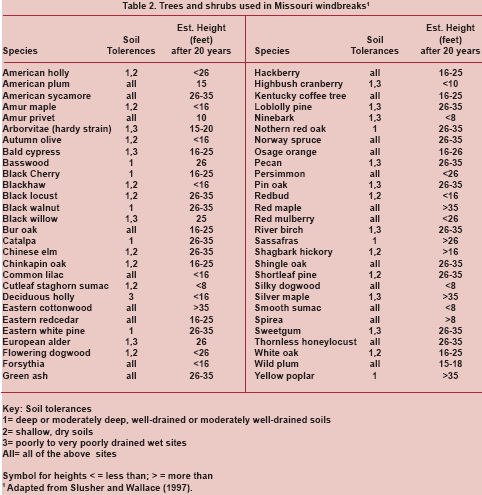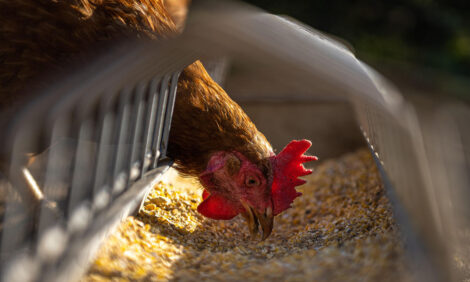



Windbreaks for Poultry Farms
By G.T. Tabler, Poultry Science Department at the University of Arkansas's Avian Advice - Windbreaks are barriers that have been used for centuries to reduce and redirect wind. They were first used in the mid-1400’s when the Scottish Parliament urged the planting of tree belts to protect agricultural production (Droze, 1977).Introduction
Windbreaks are common in regions like the Western,
North Central, and Great Plains of the United States where there is minimal forest cover, strong
winds, large amounts of snow, and extreme temperature fluctuations. However, since windbreaks
have also been used for privacy screens, dust control, odor control and noise reduction, the Arkansas
poultry industry should give them serious consideration. The ever-increasing non-farm population
influx into rural, poultry producing areas of the state is adding to the number of complaints and
lawsuits between non-farm and farm segments of the population.
Windbreaks have the potential to
address some of these problems and could improve property values. In addition, planting trees and
shrubs is seen as environmentally friendly; therefore, windbreaks around poultry houses could
further demonstrate a producer’s commitment to a safe, healthy environment now and in the future.
Windbreak Benefits
Well-designed windbreaks can cut energy costs of a typical farm or ranch home as much as 20
to 40 percent (Wight et al., 1991). Individual savings depend on the local site, climate conditions,
and building construction quality, as well as the design and construction of the windbreak. Since
windbreaks reduce the force of the wind blowing against the buildings and, in turn, the amount of
cold air entering the building, unprotected poultry houses, with poorly fitting doors, numerous
cracks or gaps and poor-quality curtains could probably benefit greatly from a well-designed
windbreak. A moderately dense windbreak will reduce a 20 mph wind to approximately 5 mph out
to a distance of five times the effective height of the windbreak. Table 1 lists wind reductions at
various distances upwind and downwind of windbreaks.

Many poultry producers also raise beef cattle. When windbreaks are used to protect cattle fed
in open pastures or lots mortality is reduced, feed efficiency is improved and weight losses are
reduced by as much as 50 percent. Studies in Iowa over a five year period showed that sheltered
cattle gained an average of 80 pounds more per year and on average consumed 129 pounds less feed
per hundredweight of gain than those not sheltered (Slusher and Wallace, 1997).
Farmstead windbreaks can also screen undesirable sights, sounds, smells and dust and thus
improve living conditions for neighbors, particularly on the downwind side. The plants within the
windbreak will absorb some odors while others may be masked by the more desirable smells of
aromatic leaves or flowering shrubs that may make up the windbreak. Windbreaks can also reduce
noise by deflecting sound off branches and tree trunks or by absorbing sound with leaves, needles,
twigs, and smaller branches. For poultry producers this could mean a reduction in noise from tunnel
ventilation fans that may, during summer, run 24 hours a day for weeks. In addition, to some
degree, undesirable noises may be masked by the more desirable sounds of singing birds attracted by
the windbreak and the rustling of leaves. For maximum effectiveness, tree and shrub belts should be
tall, dense and located closer to the noise source than to the area protected (Slusher and Wallace,
1997). Poultry farms are a common sight along many roadways in western Arkansas. Screening
these with windbreaks would remove them from the public’s eye while also beautifying your
farming operation and displaying your concern for the environment.
In temperate regions windbreaks can be a major component of successful agricultural systems.
However, to be successful, windbreak integration requires a thorough understanding of the
agricultural system involved, a basic understanding of how windbreaks work and a working
knowledge local conditions.
Height, Length and Structure of Windbreaks
Windbreak height is the most important factor determining the distance downwind protected by a windbreak. For
maximum efficiency, the uninterrupted length of the windbreak should be at least 10 times its height (Brandle et al., 2002).
Windbreaks usually require at least two kinds of trees with different growth characteristics to provide foliage density at various
heights over a period of years (Slusher and Wallace, 1997). Table 2 lists trees and shrubs that have been used in Missouri
windbreaks; many of these same species would work well in Arkansas windbreaks as well. Conifer species, such as cedar and
pine, and shrubs with multiple stems tend to provide better year-round density, while taller hardwood species, such as ash, oak, or
hackberry, generally are used to provide greater height.

The amount of wind speed reduction that occurs is determined by the structure of the trees involved. As wind flows
through a windbreak, the trunk, branches and leaves absorb some of the momentum of the wind and the roughness of the tree
surfaces further slows wind speed. However, density should be adjusted to meet particular objectives. In general, windbreaks
with higher densities (multiple rows) are used to protect wildlife, farmsteads, or homesites, while windbreaks with lower densities
are used to protect crop fields. Windbreak density is the ratio of the solid portion of the windbreak to the total area of the
windbreak. A windbreak density of 40 to 60 percent provides maximum downwind protection in addition to providing
tremendous soil erosion control (Brandle et al., 2002).
The prevailing winds in winter are from the north and northwest in Arkansas, so protective windbreaks should be located
along the north and west sides of your farmstead. However, windbreaks used for visual screening and dust, odor and noise
control near tunnel fans can be placed where needed with proper planning. Windbreaks with both deciduous and evergreen
species must have adequate space. If evergreen and deciduous trees are planted as close as 6 to 8 feet apart, the deciduous trees
will soon overshadow the evergreens. When this happens, the growth of the evergreens will be stunted, their form will be ruined
and their effectiveness greatly reduced. There must be at least 15 to 20 feet of space between rows of evergreen and deciduous
species (Slusher and Wallace, 1997).
Considerations and Tree Spacing
Slusher and Wallace (1997) suggest keeping the following considerations in mind as you plan your windbreak;
- Locate the windbreak where it will be most effective.
- Design the windbreak to fit the available space and to meet the purpose of the planting. Design must allow for proper spacing (see below) for tree growth and for use of maintenance equipment.
- Select tree and shrub species that are well adapted to your soil and climate conditions. Order trees early.
- Properly prepare the planting sight and fence areas accessible to livestock.
- Arrange for necessary planting labor and equipment.
- Provide care and protection for young seedlings.
- Provide proper management practices after windbreak establishment.
When planning the spacing of trees the probable size of the crowns after the trees reach 20 to 30 years of age should be considered. Although a wider spacing means that it will take longer for trees to form an effective wind barrier, the delay in windbreak effectiveness will be more than offset by the increased tree growth rate. In addition, trees that have adequate growing space will live longer, retain their lower limbs better and produce more foliage. Furthermore, the reduced windbreak effectiveness produced by wider spacing can be overcome by staggering the trees in adjacent rows. Rows should be spaced from 15 to 30 feet from each other, depending on the types of trees or shrubs in the adjacent row. Slusher and Wallace (1997) recommend the following spacing for various trees and shrubs:
- Space 10 to 12 feet between shrub rows.
- Space 15 to 20 feet between shrub and tree rows.
- Space 15 to 20 feet between medium and tall tree rows.
- Space 20 feet between tall evergreen rows.
- Space a minimum of 20 feet between tall evergreen and tall deciduous tree rows.
Remember that spacing must allow for proper use of suitable maintenance equipment. Between trees in a row:
- Allow 4 to 6 feet for deciduous shrubs.
- Allow 10 to 16 feet between medium-sized evergreens.
- Allow 12 to 20 feet between deciduous trees.
- Allow 10 to 16 feet between tall evergreen trees.
Summary
Winds of change are sweeping across the American agricultural landscape. The general public is no longer as tolerant of
agricultural practices as they once were. In addition, agricultural producers are a small minority of the population and must
therefore utilize strategies that allow production to increase, while at the same time, living in harmony with their neighbors and,
in turn, minimizing complaints or lawsuits from the non-farm population. One such strategy for Arkansas poultry producers is
the use of windbreaks.
Windbreaks are an old technology used to reduce wind speed but they also have the potential to visually
screen poultry houses from public view, disperse odors, dust and noise before these pollutants have a chance to affect the
neighbors. Also, in today’s environmentally conscious society, planting trees is “good” thing to do and may reflect positively on
agricultural producers who otherwise might be viewed unfavorably by much of the non-farm population. Be aware that
constructing a successful windbreak is no small undertaking so do your homework before grabbing your shovel. Contact your
local Extension office, Arkansas Forestry Commission, NRCS office, or local landscape nursery for assistance with planning and
constructing a windbreak that will meet the needs of your particular farming operation.
References
Brandle, J. R., X. Zhou, and L. Hodges. 2002. How windbreaks work. University of Nebraska Extension EC 02-1763-X.
University of Nebraska, Lincoln.
Brandle, J. R., L. Hodges, and X. H. Zhou. 2004. Windbreaks in North American agricultural systems. Agroforestry Systems
61:65-78.
Droze, W. H. 1977. Trees, Prairies, and People: A History of Tree Planting in the Plains States. USDA Forest Service and Texas
Women’s University Press, Denton, TX. 313 pp.
Slusher, J. P., and D. Wallace. 1997. Planning tree windbreaks in Missouri. MU Guide G5900. University Extension. University
of Missouri-Columbia.
Wight, B., T. K. Boes, and J. R. Brandle. 1991. Windbreaks for rural living. University of Nebraska Extension EC 91-1767-X.
University of Nebraska, Lincoln.

Source: Avian Advice - Winter 2005 - Volume 7, Number 1








